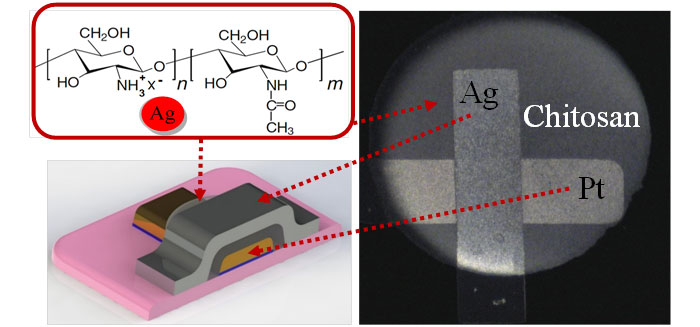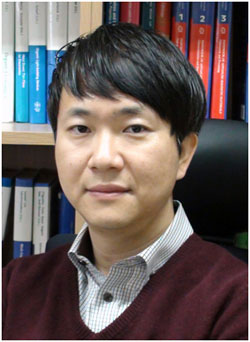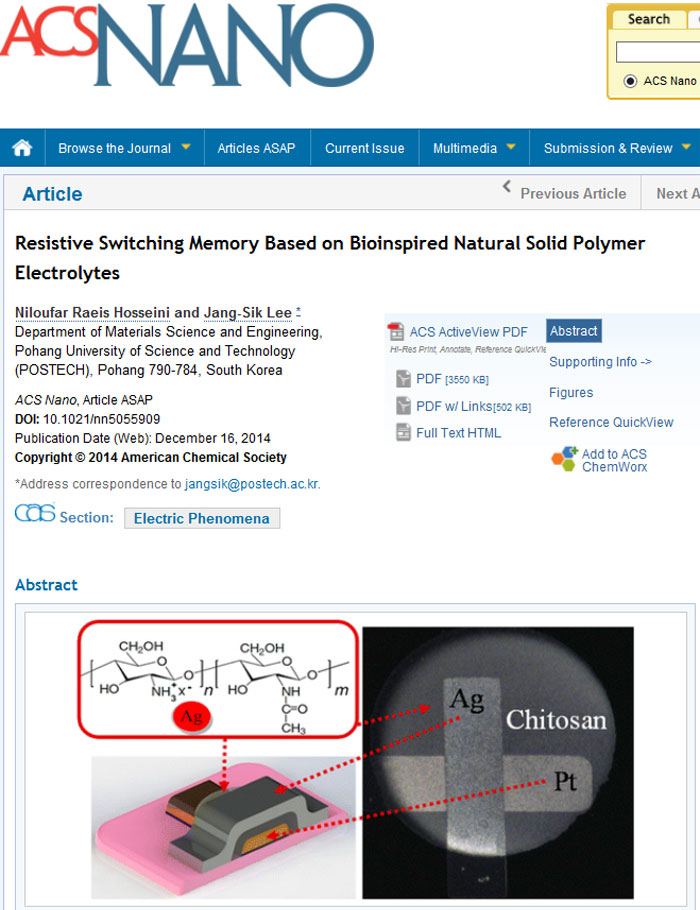A group of researchers announced on January 12 that they have developed a new technology to make memory devices from chitosan, an element extracted from shellfish, such as crabs or shrimp.
Led by Professor Lee Jang-sik, the team made a non-volatile memory device which can be used to make USB memory sticks or flash memory drives by using chitosan extracted from crab shells.
The team focused on chitosan while searching for a new, environmentally friendly and biocompatible ingredient. Chitosan has a very high ion transfer rate. The scientists also found that chitosan-based memory devices which use platinum (Pt) and silver (Ag) as electrodes can be switched reproducibly between high and low resistance states. It functions as a memory device onto which information can be saved or erased when it meets artificial changes in resistive switching states.

By using such characteristics, the chitosan-based memory device displays high compatibility in storing and erasing information many times over and it maintains its functionality as it shows reproducible and reliable bipolar resistive switching characteristics even with low power.

The researchers also emphasized that the chitosan-based memory device can be made on a flexible plastic substrate, as well. As chitosan is extracted from seafood, they said, it is cost-effective and environmentally friendly, which heightens the possibility of using it in the future as an element to make flash memory for human-friendly wearable devices, such as smart watches.
Professor Lee Jang-sik said, “The newly developed memory device is made from a biocompatible element. It will be a generic technology that can be worn on human skin or inserted into the human body. In the future, I wish to develop a safe memory device that can even be eaten.”
The research was sponsored through a support project for leading researchers by the Ministry of Science, ICT & Future Planning. The research results were published online on December 16 in ACS Nano, an international journal.

By Yoon Sojung
Korea.net Staff Writer
Photos: POSTECH
arete@korea.kr
Led by Professor Lee Jang-sik, the team made a non-volatile memory device which can be used to make USB memory sticks or flash memory drives by using chitosan extracted from crab shells.
The team focused on chitosan while searching for a new, environmentally friendly and biocompatible ingredient. Chitosan has a very high ion transfer rate. The scientists also found that chitosan-based memory devices which use platinum (Pt) and silver (Ag) as electrodes can be switched reproducibly between high and low resistance states. It functions as a memory device onto which information can be saved or erased when it meets artificial changes in resistive switching states.

The left image shows the chemical structure of chitosan and a microscopic image of a chitosan-based memory device. On the right, chitosan is put between silver (Ag) and platinum (Pt).
By using such characteristics, the chitosan-based memory device displays high compatibility in storing and erasing information many times over and it maintains its functionality as it shows reproducible and reliable bipolar resistive switching characteristics even with low power.

Professor Lee Jang-sik of POSTECH
The researchers also emphasized that the chitosan-based memory device can be made on a flexible plastic substrate, as well. As chitosan is extracted from seafood, they said, it is cost-effective and environmentally friendly, which heightens the possibility of using it in the future as an element to make flash memory for human-friendly wearable devices, such as smart watches.
Professor Lee Jang-sik said, “The newly developed memory device is made from a biocompatible element. It will be a generic technology that can be worn on human skin or inserted into the human body. In the future, I wish to develop a safe memory device that can even be eaten.”
The research was sponsored through a support project for leading researchers by the Ministry of Science, ICT & Future Planning. The research results were published online on December 16 in ACS Nano, an international journal.

Research results into chitosan-based memory devices are published online in ACS Nano on December 16.
By Yoon Sojung
Korea.net Staff Writer
Photos: POSTECH
arete@korea.kr
Most popular
- Korea.net welcomes 2025 K-influencers, Honorary Reporters
- 2025 Honorary Reporter class pledges to spread 'real Korea' worldwide
- US urged to exempt tariffs on Korea in first '2+2' trade talks
- 'Gangnam Style,' 'Baby Shark' make YouTube's 2005-25 best list
- Korean culture festival in Cuba marks 1st year of bilateral ties
